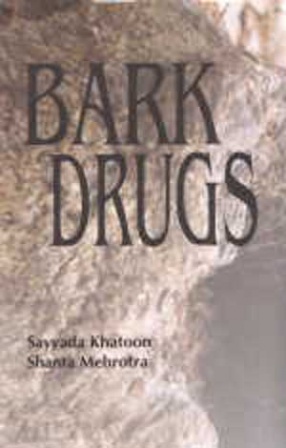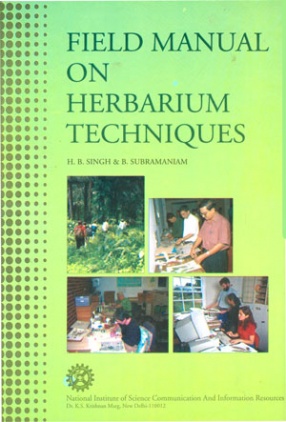
National Institute of Science Communication

Showing all 24 books









The third and final volume of the Second Supplement Series on Raw Materials encompasses entries within the alphabet Pi to Z. It covers 539 plant species belonging to 243 plant genera. Of these, nine additional species, viz Piper pedicellosum, Rhynchosia beddomei, R. heynei, R. suaveolens, Rubus Insignis, Tanacetum tibeticum, Trachycarpus takil, Vitis assamica and V. elongate reported in this volume are entirely new to Wealth of India Raw Materials. The volume ...

There is lot of adulteration and substitution of herbal raw materials, especially in case of bark drugs. Different plant materials are being sold in the market under the same vernacular, for example 'Asoka' - Saraca Asoca is the genuine plant species but bark of other plant taxa are being mixed up and sold or used under the name 'Asoka'. It is also apparent that after drying, it is very difficult to differentiate the bark of the same genus, as in ...

This is the second in the series of six volumes on the treatise on Indian medicinal plants. It incorporates one hundred and twenty species of dicotyledonous flowering plants. By and large, the features and the pattern presented in the earlier volume has been maintained. In addition, attempts have been made to specify the parts from which the important chemical constituents have been isolated. As in the previous volume, each plant is illustrated either with ...

The third volume in the series of the Treatise on Indian Medicinal Plants incorporates one hundred and twenty one species of dicotyledonous flowering plants belonging to twenty seven families. The same features and pattern of presentation of the earlier volumes have been maintained. Only the well-characterized chemical constituents have been included with the parts they have been isolated from wherever available. As before, each plant has been illustrated either ...

In the first three volumes on "The Treatise on Indian Medicinal Plants" classified informations have been given on 352 plant species used in the traditional system of medicine. This volume describes 127 plants covering twenty one botanical families maintaining the same pattern of presentation as in previous volumes. In order that the readers may be conversant with the Ayurvedic terminologies, the chapter on the "Basic Concepts of Ayurveda" has ...

The Treatise on Indian Medicinal Plants, a compilation of the indigenous drugs of plant origin used in Ayurveda is being published in six volumes. Of these, four volumes describing four hundred and seventy nine plant species have already been published. The present volume describes one hundred and sixteen species comprising ninety three genera belonging to eleven families. Some of the plants described in Volume 5 are well-known sources of drugs used today, for ...

This detailed treatise is written for botanists, chemists, biologists as a companion volume to Glossary of Indian Medicinal Plants by Chopra, Nayar & Chopra, and covers the ten-years period 1960-69. While following the general format of the 'Glossary', taking cognisance of the widespread spurt in research on medicinal plants, the write-up on each plant also includes new type of data/information. Two new sections have, therefore, been added--a section on 'New ...

This detailed treatise is written for botanists, chemists and biologists as companion volume to "Glossary of Indian Medicinal Plants" by Chopra, Nayar & Chopra, and covers the ten-year period 1970-79. Volume 1 (1960-69) was published during February 1991. The format followed for Vol. 2 is similar to that of Vol. 1, i.e. the write-up on each plant also includes new type of data/information, viz. chemical structures of new compounds isolated and the ...

This detailed treatise is written for botanists, chemists and biologists as companion volume to Glossary of Indian Medicinal Plants by Chopra, Nayar & Chopra and covers the five-year period 1980-84. Volume 1 (1960-69) was published during February 1990 and volume 2 in April 1991. The reprint editions of these volumes have come out in 1993 which contain a new index of chemical structures. Thus, these volumes have four indexes each. The format followed for Vol. ...

Scope: This compendium has been designed as a companion volume to the Glossary of Indian Medicinal Plants by Chopra, Nayar & Chopra (hereinafter referred to as glossary). All the plants have been listed in alphabetical order and reference to the glossary has been given for those plants which are included therein; in the case of new plants, not listed in the glossary, their local name and distribution has also been included, wherever known, in keeping with the ...

This detailed treatise is written for botanists, chemists and biologists as companion volume to "Glossary of Indian Medicinal Plants" by Chopra, Nayar & Chopra. Volumes 1 and 2 each covering a ten year period (1960-69 and 1970-79) were published in February, 1990 and April, 1991 respectively. The reprint editions of these volumes which came out in 1993 and later on, contained a new index of chemical structures. Succeeding volumes pertain to five ...

The first edition of the Wealth of India-Raw Materials Series, comprising 11 volumes and two supplements dealing with the Indian raw material resources of plant, animal and mineral origin, was welcomed by scientists and others, both in India and outside, as an important landmark and an outstanding and unique reference work of its kind. The present volume contains in capsule form the salient information on economic plants dealt with in The Wealth of India volumes. ...



The Wealth of India (First Supplement Series) : The Wealth of India, acclaimed as a reference standard for information on raw materials of India has in the recent past played a major role in India’s claim for priority in the US patent case on turmeric. The encyclopaedia, after conclusion of the original series and revision of the initial volumes was diverted to electronic publishing through the project AHEAD (Asian Health, Environment and ...

This book describes briefly various types of wastelands, their characteristics, causes, the importance of green cover, role of nitrogen-fixing plants and energy-crops, and other related issues. Keeping in view the growing need for timber, fuel and fodder, this book attempts to bring together information on as many wild or not-so-wild plants as possible, which, besides being useful in reclamation, also yield other economic products. Out of the 1003 species dealt ...

The present volume is the first in the series on the Treatise on Indian Medicinal Plants. The series is likely to be completed in six volumes. Volume 1 covers one hundred and eleven plants which have been classified according to the latest botanical nomenclature and is profusely illustrated, both coloured and black and white, which will help in the proper identification of plant species. The write-up on each plant includes selected vernacular names, occurrence ...

The Wealth of India, acclaimed as a reference standard for information on raw materials of India has in the recent past played a major role in India’s claim for priority in the US patent case on turmeric. The encyclopaedia, after conclusion of the original series and revision of the initial volumes was diverted to electronic publishing through the project AHEAD (Asian Health, Environment and Allied Databases) sponsored by International ...



Turmeric belongs to the elite group of spices of Indian origin. Its proven efficacy as a digestive aid, against gastric and peptic ulcers, inflammation, rheumatold-and osteo-and arthritis attracted special attention of the western world in recent years. Clinical trials also corroborated the anti-atherosclerotic, anti-carcinogenic (specially related to colon and prosrate) and anti-mutagenic effect of its active constituent, curcumin. The book fulfills a timely ...

In the Treatise on Indian Medicinal Plants seven hundred species have been described. The present volume deals with one hundred and twenty dicotyledonous flowering plants. Volume 2 was earlier published in 1992 by the publication and information directorate, Council of Scientific and Industrial Research, New Delhi, which is now designated as National Institute of Science Communication and Information Resources (NISCAIR), New Delhi. The earlier volume has been ...

The demand for Wealth of India volumes is persistently growing from its users, and hence a Second Supplement Series to the Wealth of India-Raw Materials is being launched. The series shall contain supplementary information for the period 1982-86 and 1995-96 (wherever available) for all A to Z plant entries and does not differ substantially in overall presentation and arrangement from the parent series. The volumes of this series have significant potential in the ...

The science of creation of herbarium started way back in the 16 century when Luca Ghini developed the first Herbarium. Ever since then, there has been remarkable progress both in the areas of collection of plant specimens and the techniques that have been adopted through research over the years for enhancing the storage life of herbarium specimens.
The current approaches for the use of state-of-the-art technology for collection of specimens from various groups of ...
